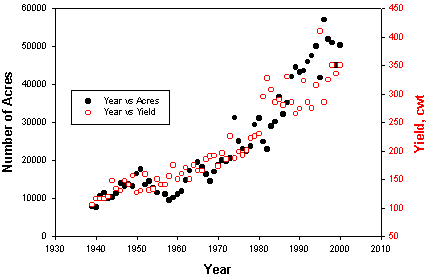Head lettuce plays a major role in Yuma economy. Lettuce gross return in Yuma is higher than any other crop grown in the county. The growing season for head lettuce starts about the last week of August and ends no later than the second week of April. Most common crop rotations practices in Yuma include lettuce-cotton, lettuce-Sudan grass- wheat.
Lettuce data were collected from Arizona Agricultural Statistics to evaluate the lettuce yield and acreage variation as affected by year from 1939 to year 2000 (Figure 1). 2 Both acreage and yield (cwt) increased linearly from 1939 to 2000 (Results from Proc Regression, SAS 8.2, not shown). The number of acres of lettuce increased from less than 10,000 acres in 1939 to 55,000 acres in 2000. Similarly, yield increased from 100 cwt per acre in 1939 to 350 cwt in 2000. Figure 1 shows that the rate of yield increase and the rate of acre increase were slower from 1939 to 1960 then a rapid increase was observed for both yield and number of acres cropped to lettuce. I notice that until 1983, Yuma County included the current La Paz County. However, most of the lettuce has been grown in the current Yuma county land.
While the factors that influenced these changes were not fully investigated, we can simply assume that from 1939 to 1960 the low yield was attributed to less advanced seed production technology, agronomic practices, integrated pest management and irrigation. The low acreage in lettuce, perishable product, during the same period might be due to low lettuce demand as result of the inadequate post harvest infrastructure such as storage, transport, the marketing and short shelf life. Low local demand might be attributed to lower population.
Figure1. Lettuce acreage and yield change as affected by years in
Yuma County, 1939-2000
Sources: Arizona Agricultural Statistics.
The rapid increase in acreage and yield starting 1960 could be due to
the result of better post harvest infrastructure of storage and transport,
marketing, improved varieties, agronomic practices and better integrated
pest management. The acreage could be have been affected by the increasing
demand due to the diet change among population, national and international
market opportunities. .
Issued in furtherance of Cooperative Extension work, acts of May 8 and June 30, 1914, in cooperation with the U.S. Department of Agriculture, James A. Christenson, Director Cooperative Extension, College of Agriculture and Life Sciences, The University of Arizona.
The University of Arizona is an equal opportunity, affirmative action institution. The University does not discriminate on the basis of race, color, religion, sex, national origin, age, disability, veteran status, or sexual orientation in its programs and activities.
Any products, services, or organizations that are
mentioned, shown, or indirectly implied in this web document do not imply
endorsement by The University of Arizona.
Information provided by:
Barry Bequette, plantdoc@ag.arizona.edu Extension Agent, Urban Horticulture
Barry Tickes, btickes@ag.arizona.edu Extension Agent, Yuma County
Mohammed Zerkoune, zerkoune@ag.arizona.edu Extension Agent, Agriculture
University of Arizona, Tucson, Arizona.
Material written January 2003.
For more Arizona Production Ag Information:
Home | Cotton | Veggies| Forages | Grains | Citrus | Crop x Crop | Insects | Diseases| Weeds | Pesticides | News | Weather | Research | Photos | Contacts | General Info. | Site Map
document located at: http://cals.arizona.edu/crops/counties/yuma/farmnotes/fn0103acrelettuce.html
Copyright © 2001 University of Arizona,
College of Agriculture and Life Sciences
Webmaster: Al Fournier (fournier@ag.arizona.edu)
